Publications
The Future Agricultures Consortium produces research in a variety of formats.Several key research series are available for download, circulation and citation.
Use the search field below or review our thematically structured research archive.
Latest articles
Future Agricultures Consortium
February 12, 2009 / MeetingsBy Ian Scoones and John Thompson
12 February 2009
Our mission:
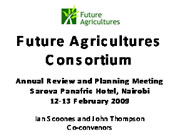 “to encourage dialogue and the sharing of good practice by policy makers and opinion formers in Africa on the role of agriculture in broad based growth”. But aren’t others doing this? CAADP (with the legitimacy of an international governmental process) and AGRA, IFPRI and others (with lots of money)…..likely to be others, So where do we fit?, What do we do that is different?
“to encourage dialogue and the sharing of good practice by policy makers and opinion formers in Africa on the role of agriculture in broad based growth”. But aren’t others doing this? CAADP (with the legitimacy of an international governmental process) and AGRA, IFPRI and others (with lots of money)…..likely to be others, So where do we fit?, What do we do that is different?
Agriculture and Food Security: Pre-Evaluation Review of DFID Policy
February 3, 2009 / MiscellaneousJohn Wyeth, Steve Ashley{jathumbnail off}{jcomments off}
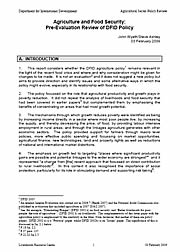 This report considers whether the DFID agriculture policy remains relevant in the light of the recent food crisis and where and why consideration might be given for changes to be made. It is not an evaluation2 and it does not suggest a new policy but aims to provide direction and identify issues and some alternative ways in which the policy might evolve, especially in its relationship with food security.
This report considers whether the DFID agriculture policy remains relevant in the light of the recent food crisis and where and why consideration might be given for changes to be made. It is not an evaluation2 and it does not suggest a new policy but aims to provide direction and identify issues and some alternative ways in which the policy might evolve, especially in its relationship with food security.
The policy focussed on the role that agricultural productivity and growth plays in poverty reduction. It did not repeat the analysis of livelihoods and food security that had been covered in earlier papers3 but complemented them by emphasising the benefits of concentrating on areas that had most growth potential.
The mechanisms through which growth reduces poverty were identified as being by increasing income directly in a sector where most poor people live; by increasing the supply, and thereby decreasing the price, of food; by providing labour intensive employment in rural areas; and through the linkages agriculture generates with other economic sectors. The policy provided support for farmers through macro level policies, more effective public spending and focussing on market opportunities, agricultural finance, new technologies, land and property rights as well as reductions of national and international market distortions.
Agriculture and Food Security: Pre-Evaluation Review of DFID Policy
February 3, 2009 / External AnalysisJohn Wyeth, Steve Ashley
This report considers whether the DFID agriculture policy remains relevant in the light of the recent food crisis and where and why consideration might be given for changes to be made. It is not an evaluation and it does not suggest a new policy but aims to provide direction and identify issues and some alternative ways in which the policy might evolve, especially in its relationship with food security.
Fertiliser Subsidies: Lessons from Malawi for Kenya
February 1, 2009 / Policy Briefs By Colin Poulton
February 2009
Since 2005/06 a large-scale agricultural inputs subsidy programme has been in place in Malawi, which, combined with good rains, has resulted in the country moving from chronic food insecurity to maize surplus. This in turn has excited interest in fertiliser subsidies in other countries, including Kenya (itself chronically maize deficit). In this briefing note we summarise some of the key lessons learnt from evaluation of the Malawi fertiliser subsidy to date. Some of these are directly applicable to Kenya. However, the agro-ecological political and market contexts of Malawi and Kenya are different, so we also consider how these differences affect the transferability of the fertiliser subsidy programme.
Agriculture and Social Protection in Ethiopia
January 11, 2009 / Working PapersStephen Devereux and Bruce Guenthe
January 2009
Agriculture and social protection in Ethiopia are inextricably interconnected. Smallholder farming is the dominant livelihood activity for the majority of Ethiopians, but it is also the major source of vulnerability to poverty, food insecurity and their often fatal consequences– chronic malnutrition, premature mortality, recurrent famines. Ethiopian farmers have been the recipients of enormous volumes of food aid and other humanitarian assistance over recent decades, to such an extent that emergency relief has become institutionalised within government structures and donor agency country programmes.
Agriculture and Social Protection in Ghana
January 11, 2009 / Working PapersGhana was one of the first countries in Africa to embark on structural adjustment reforms. 25 years on, its continuing commitment to reform for national economic development has yielded impressive gains in growth and poverty reduction. Poverty in the country is measured through periodic Ghana Living Standards Surveys (GLSS). In 1991/92 GLSS3 found that 51.7%of the population were living below the national poverty line. By 1998/99 (GLSS4) this had fallen to 39.5% and by 2005/06 (GLSS5) it had fallen to 28.5% (Ghana Statistical Service2007). In absolute terms the number of poor people in Ghana has fallen from 7.9 million in 1991/92 to 6.2 million in 2005/06. At current growth rates, Ghana should achieve MDG1before 2010.
Building synergies between social protection
January 1, 2009 / MiscellaneousBy Rachel Sabates Wheeler, Stephen Devereux and Bruce Guenther
January 2009
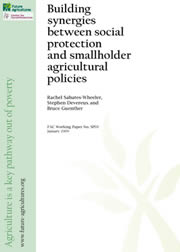 The paper explores how social protection and agricultural policies interact, creating either synergies or conflicts between them. To the extent that social protection measures help poor rural people expand their assets, use them more efficiently and adopt higher return activities,there should be strong synergies with agricultural development. Reverse synergies can also arise,if agricultural policies help farmers improve their livelihoods and reduce their vulnerability.
The paper explores how social protection and agricultural policies interact, creating either synergies or conflicts between them. To the extent that social protection measures help poor rural people expand their assets, use them more efficiently and adopt higher return activities,there should be strong synergies with agricultural development. Reverse synergies can also arise,if agricultural policies help farmers improve their livelihoods and reduce their vulnerability.
But conflicts can occur if policy objectives are inconsistent with each other, and these are alsoexamined in this paper. We draw on numerous examples from the across the globe, but withspecific emphasis from the African continent to highlight issues including, liquidity constraints,scale and threshold effects, timing, seasonality and policy complementarities. In conclusionwe consider lessons for how the agricultural policies and social protection instruments can bedesigned and implemented to exploit welfare and growth synergies.
After a lengthy period of relative neglect, agriculture is back on the policy agenda of many African governments and international agencies. Smallholder farming is recognised by the Commission for Africa, NEPAD and others as central to rural livelihoods and therefore indispensable to food security and poverty reduction and the achievement of the Millennium Development Goals (MDGs) in Africa. At the same time, however, the multiple risks and vulnerabilities that smallholders face are increasingly well understood, and new policy frameworks are emerging that distinguish between different types and sources of risk (for example, idiosyncratic and covariant risk affecting agricultural production, markets and health) and between different response options (investment in crop or livestock protection, irrigation, market stabilisation and access, cash transfers, and so on).
Reducing risk in smallholder farming requires agricultural development policies, and policies that create a conducive enabling environment for agriculture, while managing risk in smallholder farming requires social protection policies that can also contribute to reducing risk. The paper analyses how social protection and agricultural policies interact, creating either synergies or conflicts between them.
We explore both current and potential synergies and conflicts between ‘welfare-promoting’ and ‘growth-promoting’ forms of social protection and agricultural development. To the extent that social protection measures help poor rural people expand their assets, use them more efficiently and adopt higher return activities, there should be strong synergies with agricultural development. Reverse synergies can also arise, if agricultural policies help farmers improve their livelihoods and reduce their vulnerability. But conflicts can occur if policy objectives are inconsistent with each other, and these are also examined in this paper.
{jathumbnail off}{jcomments off}
Social Protection Series Poverty, Livelihoods and Vulnerability in Northern Ghana
January 1, 2009 / MiscellaneousBy Ramatu Al-Hassan and Colin Poulton
January 2009
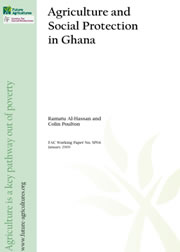
Ghana was one of the first countries in Africa to embark on structural adjustment reforms. 25 years on, its continuing commitment to reform for national economic development has yielded impressive gains in growth and poverty reduction. Poverty in the country is measured through periodic.
Ghana Living Standards Surveys (GLSS). In 1991/92 GLSS3 found that 51.7% of the population were living below the national poverty line. By 1998/99 (GLSS4) this had fallen to 39.5% and by 2005/06 (GLSS5) it had fallen to 28.5% (Ghana Statistical Service2007). In absolute terms the number of poor people in Ghana has fallen from 7.9 million in 1991/92 to 6.2 million in 2005/06. At current growth rates, Ghana should achieve MDG1before 2010. However, the fall in poverty has not been experienced equally around the country.
GLSS5 figures show poverty headcount rates in the five southern regions of the country of between12% (Greater Accra) and 20% (Ashanti, Central, Eastern, Western). These regions have all seen dramatic falls in poverty since 1991/92 due to urban growth, minerals extraction and,in the recent survey period, a boom in the cocoa sector in response to higher world prices and domestic market reforms and production support. The “transitional” regions, Brong Ahafo and Volta, have also witnessed impressive falls in poverty to around 30% in 2005/06. However, poverty in the three northern regions – Northern, Upper East and Upper West –remains stubbornly high at 52-88%.
In 2005/06 the three northern regions accounted for just under 22% of the population, but 45% of the headcount poor, 57% of the headcount extreme poor and 80% of extreme poverty severity1 in the country (Ghana Statistical Service 2007). The livelihood classification used by GLSS shows poverty to be concentrated amongst “foodcorp farmers”, who are encountered disproportionately (but not exclusively) within the three northern regions. This group accounted for 43% of the population in 2005/06, but 69% of the headcount poor. Whilst the poverty rate amongst “food crop farmers” (68%) and “export The P2 poverty measure using the lower (extreme poverty) line.
{jcomments off}
Agriculture and Social Protection in Ethiopia
January 1, 2009 / MiscellaneousBy Stephen Devereux and Bruce Guenther
January 2009
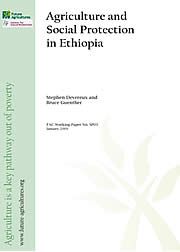 Agriculture and social protection in Ethiopia are inextricably interconnected. Smallholder farming is the dominant livelihood activity for the majority of Ethiopians, but it is also the major source of vulnerability to poverty, food insecurity and their often fatal consequences– chronic malnutrition, premature mortality, recurrent famines. Ethiopian farmers have been the recipients of enormous volumes of food aid and other humanitarian assistance over recent decades, to such an extent that emergency relief has become institutionalised within government structures and donor agency country programmes.
Agriculture and social protection in Ethiopia are inextricably interconnected. Smallholder farming is the dominant livelihood activity for the majority of Ethiopians, but it is also the major source of vulnerability to poverty, food insecurity and their often fatal consequences– chronic malnutrition, premature mortality, recurrent famines. Ethiopian farmers have been the recipients of enormous volumes of food aid and other humanitarian assistance over recent decades, to such an extent that emergency relief has become institutionalised within government structures and donor agency country programmes.
The discourse surrounding the complex relationship between agriculture and social protection in Ethiopia can be approached from either perspective. From the agricultural policy perspective, the government’s unshakeable belief in the centrality of farming as the backbone and potential source of growth for the Ethiopian economy is mirrored by its almost ideological view that land is the ultimate ‘safety net’ for rural households, who should therefore be protected against losing their access to land – by being prevented from selling it.
From the social protection perspective, awareness that able-bodied farmers are the main‘beneficiaries’ of safety nets and humanitarian food aid has fuelled the government’s visceral fear of creating ‘dependency’ in rural communities, which in turn explains the predominance of public works projects as their preferred delivery mechanism for food aid, as well as recent shifts in safety net thinking towards cash transfers rather than food aid, with predictable multi-annual transfers expected to lead to ‘graduation’ within a defined time period.
{jathumbnail off}{jcomments off}
Agriculture and Social Protection in Malawi
January 1, 2009 / Working PapersAndrew Dorward, Bruce Guenther and Rachel Sabates-Wheeler
January 2009
This paper reviews social protection and agriculture policies in Malawi in order to explore the links, synergies and conflicts that lie between them. It begins with brief background information about Malawi, in terms of its economic and welfare indicators. Particular emphasis is placed on understanding agricultural and social protection policies within thecontext of:
(a) Political issues and
(b) Market and livelihood development
This is followed with a review of agricultural and social protection policies, their interactions and their impacts on livelihoods and welfare. Specific attention is given to evolving input subsidy policies which are of particular relevance to this review. We conclude with a discussion of lessons that can be learned from the Malawian experience with agriculture and social protection.
Improving access to input & output markets
December 8, 2008 / Research PapersBy Andrew Dorward, Ephraim Chirwa and Colin Poulton
December 2008
Agriculture can play two potential roles in wider economic growth,fundamental increases in productivity and earnings) and/or multiplying and spreading the benefits of primary growth drivers through an economy. Growth drivers include exports of tradables and increased production of foods (both tradables and non-tradables). Non-tradable staple foods have particular importance in poor rural economies as they are important to the real incomes of large numbers of poor net food consumers and small scale net producers, and they tend to have high positive growth linkages and low leakages. Increased production of non-staple horticultural and livestock products for domestic consumption are important as growth supports where these are semi-tradeables or non-tradeables, but are only effective in the context of an economy benefiting from other growth drivers.
Consideration of the contributions of different types of agricultural production in the context of wider national growth processes allows the contributions of different types of smallholder agricultural development to be placed in the context of different types of economy. Three broad types ofeconomy are identified – countries with minerals, coastal countries without minerals, and land locked countries without minerals. Challenges and opportunities facing the development of smallholder production of different agricultural products are also identified.
Improving access to input & output markets
December 8, 2008 / Research PapersAndrew Dorward, Ephraim Chirwa and Colin Poulton
December 2008
Agriculture can play two potential roles in wider economic growth,fundamental increases in productivity and earnings) and/or multiplying and spreading the benefits of primary growth drivers through an economy. Growth drivers include exports of tradables and increased production of foods (both tradables and non-tradables).Non-tradable staple foods have particular importance in poor rural economies as they are important to the real incomes of large numbers of poor net food consumers and small scale net producers, and they tend to have high positive growth linkages and low leakages. Increased production of non-staple horticultural and livestock products for domestic consumption are important as growth supports where these are semi-tradeables or non-tradeables, but are only effective in the context of an economy benefiting from other growth drivers.
Consideration of the contributions of different types of agricultural production in the context of wider national growth processes allows the contributions of different types of smallholder agricultural development to be placed in the context of different types of economy. Three broad types ofeconomy are identified – countries with minerals, coastal countries without minerals, and land locked countries without minerals. Challenges and opportunities facing the development of smallholder production of different agricultural products are also identified.
Agricultural Commercialisation in Coffee Growing Areas of Ethiopia
October 31, 2008 / Research PapersThe coffee sub-sector is very important to the Ethiopian economy – in 2005, coffee export generated 41% of foreign exchange earnings – and provides income for approximately 8 million smallholder households. Policy attention to the sector was always considerable, and its importance has been renewed in the latest Poverty Reduction Strategy, the Plan for Accelerated and Sustained Development to End Poverty (PASDEP). PASDEP puts forward a development strategy based on accelerated economic growth, part of which is hoped to be achieved via increased smallholder commercialisation and market integration.
This paper addresses commercialisation in selected coffee growing areas in Ethiopia. The objectives of the study were (i) to assess the scale of commercialisation in coffee growing areas and to detect household and farm characteristics which might explain variation in the levels of coffee commercialisation among households; and (ii) to answer two separate questions: why some sampled households didn’t take part in output markets (i.e. identify determinants of market entry) and why some households sold more products than others (i.e. determinants of market supply). Answering these questions will help to identify policy options promoting market participation and commercialisation of smallholder agriculture.
Sequencing of Investments for Agricultural Growth, Poverty Reduction and Food Security
October 31, 2008 / Discussion PapersBy Andrew Dorward
As investment in agricultural development gains increasing prominence in Africa among governments and donors, there is renewed interest in developing strategic understanding of the investments that are needed to effectively and efficiently promote agricultural growth to benefit the poor and improve food security.
Agricultural Commercialisation in Coffee Growing Areas of Ethiopia
October 31, 2008 / Research PapersSamuel Gebreselassie and Eva Ludi
March 2008
The coffee sub-sector is very important to the Ethiopian economy. In 2005, coffee exports generated 41% of foreign exchange earnings and provides income for approximately 8 million smallholder households. Policy attention to the sector was always considerable, and its importance has been renewed in the latest Poverty Reduction Strategy, the Plan for Accelerated and Sustained Development to End Poverty (PASDEP). PASDEP puts forward a development strategy based on accelerated economic growth, part of which is hoped to be achieved via increased smallholder commercialisation and market integration.
Sequencing of Investments for Agricultural Growth, Poverty Reduction
October 31, 2008 / Miscellaneous{jathumbnail off}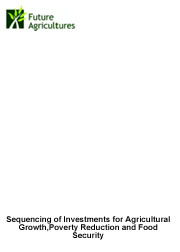 As investment in agricultural development gains increasing prominence in Africa, amonggovernments and donors, there is renewed interest in developing strategic understanding of theinvestments that are needed to effectively and efficiently promote agricultural growth to benefit thepoor and improve food security.
As investment in agricultural development gains increasing prominence in Africa, amonggovernments and donors, there is renewed interest in developing strategic understanding of theinvestments that are needed to effectively and efficiently promote agricultural growth to benefit thepoor and improve food security.
This is a matter of particular concern in the design andimplementation of NEPAD’s Comprehensive Africa Agriculture Development Program. NEPADand its partners are therefore planning to establish Regional Strategy and Knowledge SupportSystems (to be called ReSAKSS) to develop information and analytical capabilities to support theprioritization, design, implementation, and monitoring and evaluation of investment programs andactivities.
A meeting was held in Washington in June 2006 to discuss the establishment of theseReSAKSS. Attended by representatives from research institutions, regional economic communities,and donors, the two day meeting discussed first critical analytical issues that these systems andneed to address and process for the successful establishment of these systems. A critical issue for design of investment programmes is to ensure that investments are correctlysequenced.
To understand this, it is a necessary first to understand the major processes and stagesof agricultural development, of economic growth, and of poverty reduction.Agricultural growth, poverty reduction, and food security require complementary changes inpeople’s livelihoods and in the local and national economic environment. Livelihoods can behelpfully considered in terms of their contribution to three broad strategies which we term “hangingin” (maintenance and survival), “stepping up” (improvement and expansion of current activities),and “stepping out” (branching out to new activities).
These strategies are not mutually exclusive:most of us have some concerns to “hang in”, but development involves increasing opportunities for“stepping up” and “stepping out”. These transitions are particularly important to poor rural people,for whom agriculture is a major vehicle for “hanging in”, and, with agricultural growth, for“stepping up”. In the long run, however, agriculture is something from which most people “stepout” to employment in non-farm activities.
The growth of non farm employment opportunities,however, depends upon growth and structural change in the wider economy, including, of course,“stepping up” growth in agriculture.The processes of livelihoods and economic change and growth are highly inter-related anddependent upon each other. They depend upon, and are driven by, technical and institutionalchange which again interact and depend upon each other to raise the productivity of resources andfacilitate capital accumulation. Unfortunately, though, these processes can be impeded by a set ofmicro-, meso-, and macro- poverty traps.
Micro traps are well known, a vicious circle where peoplehave limited resources, which lead to low productivity, which leads to low incomes, which thenprevent the accumulation of resources. The trap is exacerbated by vulnerability to health, climate,and economic stresses and shocks, vulnerability which is increased by the low incomes and limitedresources of poor people.
FAC_E-Debate-Contributions-Soil_Fertility
October 1, 2008 / Soil FertilityAt least in the semi-arid regions of Africa, if within-field soil variability is not taken into account, efforts to increase soil fertility will be less efficient and less likely tobe adopted by farmers. Most of these farmers already practice precision agriculture and take short distance variability into consideration in their management.
One can safely assume that they do so for good reason, given that their management systems have developed over many centuries. Precision agriculture is also relevant for the introduction of modern technologies. For example, the same principles are relevant to the efficient application of manure and the efficient application of compost and mineral fertiliser. For the best solutions, farmer knowledge, extensionist knowledge and researcher knowledge of within-field soil variability need to be combined.
This will lead to an increase in the knowledge of each group regarding the variability-related possibilities and constraints of the other groups. Increased farmer knowledge will lead to better and more efficient farmer management. Increased researcher knowledge of soil variability will lead to better-targeted and more efficient soil fertility research. If the minimum management area for farmers is part of a field,and researchers only analyse at the level of an entire field or experiment, then those researchers ignore information that is very relevant to the farmers.
They should look for variables at the plot level that help explain why, in any one year as well as over the years, different plots with the same treatment react differently. They will find this useful for increasing their agro-ecological knowledge, for improving their scientific publications, and especially for more effective extension to the farmers. Farmers prefer well differentiated advice to blanket advice that turns out not to work part of the time, or in sections of their fields.
Development Issues Kenya
October 1, 2008 / FAC DocumentsThe overall context is the alarming decline in the growth of farm output in Kenya over the last fifteen or more years. As Figure 1 shows, from the late 1980s the growth of agricultural production has stagnated and fallen behind population growth. Production per head of population is now slightly below what it was at Independence in 1964.
The modern Kenyan economy has been built on agriculture, starting with the development oflarge-scale commercial farms owned by white settlers in the first half of the C20. Followingthe Swynnerton Plan of 1954, a drive to develop the smaller holdings operated by Africanfarmers began. For almost thirty years thereafter, before and after Independence in 1964,smallholder development in the higher potential parts of Kenya was successfulto drive agricultural growth ahead of the country’s rapid population expansion. Smallholdersincreased notably their output of coffee, tea, pyrethrum, and cotton for export and producedlarge amounts of maize, beans, sugar, beef, and dairy for the domestic market.
FAC Documents-Research Interests
October 1, 2008 / FAC DocumentsResearch interests of key members of the Consortium
African Green Revolution E-Forum Discussion Outline
October 1, 2008 / E-debatesThe Salzburg Global Seminar (SGS), in partnership with the Future Agricultures Consortium (FAC) and the Institute of Development Studies (IDS), has undertaken a series of events on the theme of an “African Green Revolution”.
The main purpose of these initiatives is to assess the most critical issues and to review, refine and articulate an agenda for a new sustainable “Green Revolution” for Sub-Saharan Africa. The series of events began with a high-level Conference (30 April – 2 May 2008) and subsequent Seminar (3 – 7 May 2008) where delegates were tasked with answering the question: What are the core elements of a “uniquely African Green Revolution”?
Dynamics And Diversity Soil Fertility And Farming Livelihoods In Africa Case studies from Ethiopia,M
September 1, 2008 / E-debatesThe reasons for the very significant gap between potential and realized foodproduction in sub-Saharan Africa are multiple and complex. The decline infertility observed for many areas of soil has been described as the single mostimportant factor. Although this is a challengeable statement it undoubtedlyrefers to an ever-present reality for the majority of farmers in the continent -that optimizing the nutrient balance on their farms is one of the most difficultof the many agricultural management challenges they face.
The Global Fertiliser Crisis and Africa
June 1, 2008 / MiscellaneousBy Blessings Chinsinga
June 2008
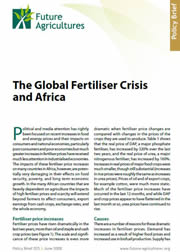 Political and media attention has rightly been focused on recent increases in food and energy prices and their impacts on consumers and national economies, particularly poor consumers and poor economies but much greater increases in fertiliser prices have received much less attention in industrialised economies.
Political and media attention has rightly been focused on recent increases in food and energy prices and their impacts on consumers and national economies, particularly poor consumers and poor economies but much greater increases in fertiliser prices have received much less attention in industrialised economies.
The impacts of these fertiliser price increases on many countries in Africa, however, are potentially very damaging in their effects on food security, poverty, and long term economic growth. In the many African countries that are heavily dependent on agriculture the impacts of high fertiliser prices and scarcity will extend beyond farmers to affect consumers, export earnings from cash crops, exchange rates, and the whole economy.
Fertiliser price increases
Fertiliser prices have risen dramatically in the last two years, more than oil and staple and cash crop prices (see figure 1). The scale and significance of these price increases is even more dramatic when fertiliser price changes are compared with changes in the prices of the crops they are used to produce. Table 1 shows that the real price of DAP, a major phosphate fertiliser, has increased by 320% over the last two years, and the real price of urea, a major nitrogenous fertiliser, has increased by 160%. Increases in real prices of major food crops were much smaller, though still substantial (increases in rice prices were roughly the same as increases in urea prices). Prices of oil and of export crops, for example cotton, were much more static. Much of the fertiliser price increases have occurred in the last 12 months, and while DAP and crop prices appear to have flattened in the last month or so, urea prices have continued to rise.
Causes
There are a number of reasons for these dramatic increases in fertiliser prices. Demand has increased as a result of higher food prices and increased use in biofuel production. Supply has been affected by increasing energy costs (which are particularly important in producing nitrogenous fertilisers), the introduction of export tariffs on some fertilisers (for example by China in April 2008), and capacity limits in expanding production to meet rising demand – particularly for phosphate rock. These influences have to be seen in the context of large shifts of funds into commodities, particularly into commodity index funds. These shifts have been encouraged by the fall in the value of the US dollar and low US interest rates, with the development of new commodity index investment instruments and funds (Masters, 2008).{jathumbnail off}{jcomments off}
The Global Fertiliser Crisis and Africa
June 1, 2008 / Policy BriefsBy the Future Agricultures Consortium
June 2008
Political and media attention has rightly been focused on recent increases in food and energy prices and their impacts on consumers and national economies, particularly poor consumers and poor economies but much greater increases in fertiliser prices have received much less attention in industrialised economies. The impacts of these fertiliser price increases on many countries in Africa, however, are potentially very damaging in their effects on food security, poverty, and long term economic growth. In the many African countries that are heavily dependent on agriculture the impacts of high fertiliser prices and scarcity will extend beyond farmers to affect consumers, export earnings from cash crops, exchange rates, and the whole economy.
Getting Agricultural Moving: Role of the State in Increasing Staple Food Crop Productivity…
June 1, 2008 / Research PapersGetting Agricultural Moving: Role of the State in Increasing Staple Food Crop Productivity with Special Reference to Coordination, Input Subsidies, Credit and Price Stabilisation
By Colin Poulton and Andrew Dorward
June 2008
This paper argues that the state has a large potential role in increasing staple food crop productivity as a result of:
- The importance of staple food crop intensification in driving and supporting pro-poor growth in poor rural areas
- Active state involvement was a pervasive feature of Asian green revolutions, but the task is not easy, particularly with the varied and often difficult agro-ecological conditions in Africa, the lack of irrigation infrastructure, likely impacts of climate change, the limited human and financial resources available to governments, and the political challenges facing governments in pursuing consistent policies.
- Increasing staple food crop productivity requires governments, with private sector actors, farmers and civil society, to address a number of challenges.
These are posed by specific technical constraints to productivity increases:
- Lack of important public goods (principally infrastructure and institutions)
- Recent dramatic increases in food and fertiliser prices; poor policy coordination
- Lack of complementary coordination in rural service development and provision
- The food price/ productivity tightrope
- Un-affordability of on-farm productivity investments; and high price instability
The nature of and solutions to these challenges, and hence the nature and importance of responses to them, vary between three different types of crop – characterised as high response cereals (maize and rice), low response cereals (sorghum and millet), and roots and tubers (cassava and yams).
The crisis of pastoralism?
May 1, 2008 / Discussion PapersBy Stephen Devereux and Ian Scoones
May 2008
part of discussions on the future of pastoral production systems in East Africa there have been a number of recent interventions arguing that something urgently needs to be done to deal with a Malthusian style crisis in pastoral areas. In short, the argument goes, there are too many people which, combined with a declining (or not increasing) productivity of the natural resource base, means that not enough livestock can be kept to sustain a viable pastoral system.
This argument has been most eloquently and effectively argued by Stephen Sandford in “Too many people, too few livestock: the crisis affecting pastoralists in the Greater Horn of Africa”. This is a response to this piece, aimed at sparking a wider discussion.and another focusing on the market potentials of a ‘livestock revolution’ What should we make of these positions? What should the practical and policy responses be?
Such a discussion is urgently needed. For at the same time as the pessimistic prognoses about pastoralist futures in the Greater Horn of Africa, there has been, for the first time in several decades, a revival of interest in pastoralism and livestock production. This takes two forms – one a celebration of the ‘pastoral way of life’ and the importance of indigenous systems of production and management
{jathumbnail off}
The crisis of pastoralism?
May 1, 2008 / Discussion PapersBy Stephen Devereux and Ian Scoones
As part of discussions on the future of pastoral production systems in East Africa there have been a number of recent interventions arguing that something urgently needs to be done to deal with a Malthusian style crisis in pastoral areas. In short, the argument goes, there are too many people which, combined with a declining (or not increasing) productivity of the natural resource base, means that not enough livestock can be kept to sustain a viable pastoral system. This argument has been most eloquently and effectively argued by Stephen Sandford in “Too many people, too few livestock: the crisis affecting pastoralists in the Greater Horn of Africa”. This is a response to this piece, aimed at sparking a wider discussion.
The Politics of Hunger: How Illusion and Greed Fan the Food Crisis
April 16, 2008 / Small Farm / Big Farm“…reluctant peasants are right: their mode of production is ill suited to modern agricultural production, in which scale is helpful. In modern agriculture, technology is fast-evolving, investment is lumpy, the private provision of transportation infrastructure is necessary to counter the lack of its public provision, consumer food fashions are fast-changing and best met by integrated marketing chains, and regulatory standards are rising toward the holy grail of the traceability of produce back to its source….
Large organizations are better suited to cope with investment, marketing chains, and regulation. Yet for years, global development agencies have been leery of commercial agriculture, basing their agricultural strategies instead on raising peasant production. ….to ignore commercial agriculture as a force for rural development and enhanced food supply is surely ideological
…Over time, African peasant agriculture has fallen further and further behind the advancing commercial productivity frontier, and based on present trends, the region’s food imports are projected to double over the next quarter century. ….There are partial solutions to such problems through subsidies and credit schemes, but it should be noted that large-scale commercial agriculture simply does not face this particular problem: if output prices rise by more than input prices, production will be expanded.
A model of successful commercial agriculture is, indeed, staring the world in the face. In Brazil, large, technologically sophisticated agricultural companies have demonstrated how successfully food can be mass-produced. …..
…There are many areas of the world that have good land that could be used far more productively if properly managed by large companies. Indeed, large companies, some of them Brazilian, are queuing up to manage those lands. Yet over the past 40 years, African governments have worked to scale back large commercial agriculture…….
…Commercial agriculture is not perfect. Global agribusiness is probably overly concentrated, and a sudden switch to an unregulated land market would probably have ugly consequences. But allowing commercial organizations to replace peasant agriculture gradually would raise global food supply in the medium term.” (Full text: The Politics of Hunger: How Illusion and Greed Fan the Food Crisis)
Collier, Paul. “The Politics of Hunger: How Illusion and Greed Fan the Food Crisis.” Foreign AffairsNovember/December 2008
Sabine Homann and Barbara Rischkowsky
April 14, 2008 / Pastoralism in crisis?This contribution summarizes insights gained from a case study on the applicability of indigenous knowledge (IK) in range management of Borana pastoralists in a changed environment (Homann, 2004). We reflect on implications for future interventions that aim at improving pastoral livelihoods under the existing constraints.
Borana pastoralists were once famous for most effective range management. Based on a deep technical and organizational IK, they have preserved highest grazing potential among East African rangelands. However, within only 30 years, well intended but poorly designed development interventions (poorly-integrated water and rangeland development, imposed formal administration, promotion of crop cultivation and ranching, unfavorable policy directives), aggravated by human population growth, contributed to the destruction of pastoralists’ basic preconditions in range management.
In the current land use scenario, uncontrolled land use is expanding, since indigenous rangeland categories have lost their functionality. The seasonal grazing system is breaking up, including long distance movements associated with a high variability in stocking densities across the landscape. Instead, encampments, permanent grazing and new forms of cultivation and private grazing enter formerly seasonal grazing areas, and herd movements become short-term oriented to follow scattered forage resources where they emerge. Reduced and poorly coordinated mobility impedes the ecologically desirable variability in stocking densities, implying negative effects on rangeland condition. A crucial question is what elements of pastoral range management remain, that can sustain controlled rangeland utilization, and revert rangeland degradation in this process.
The following changes reflect the deterioration of the pastoral system and need to be addressed by interventions that aim at improving the livelihoods for pastoralists:
– Rangeland degradation: Borana pastoralists’ perception of land use changes matched with the results from ecological range condition assessment (Dalle, 2004). According to pastoralists’ observations, an increased grazing pressure in areas that were formerly temporarily used by mobile herds causes shortage of grazing resources particularly at home-based pastures for lactating herds, aggravated by the alienation of rangeland for crop-cultivation and private grazing. Pastoralists’ observed a direct impact of degraded rangelands on reduced milk production and conception rates. They showed awareness that rangeland degradation directly affects livestock production and presents a high risk for food security in the region. Research and Development efforts to prevent rangeland degradation however had a very low impact (Coppock, 1994).
– Human population growth and socio-economic inequality: Human population growth, despite higher stocking densities, contributed to impoverishment of Borana families evident in lower cattle to human ratio. Within the studied areas, 88% of the households did not achieve the human support capacity defined as 3 TLU per AAME, and thus cannot sustain their livelihoods from livestock (Sandford and Habtu, 2000). In addition to that, socio-economic inequality within and between pastoral communities increased. In Dida Hara, site with water development in a former rainy season grazing area, 6% of the households were classified as better-off and owned over 37 times more cattle than the poor. While in Web, traditional dry season grazing area, all households were poor. The insufficient economic capacities restrict herd mobility for the majority of Borana pastoralists. To alleviate their economically disastrous situation, Borana pastoralists have tried to adopt crop cultivation. Poverty induced crop cultivation however undermines the ecologically more appropriate mobility-based land use system. On the other side, wealthy herd-owners started acting against the interests of the community, by over-stocking the communal rangelands, and stabilizing their property through rapid re-investment in herds after a drought. Considering the fact that alternative income options for Borana pastoralists are few, the dependency on livestock is very high and this destroys pastoralists ability to manage their resources sustainably.
– Erosion of indigenous institutions and negotiation procedures: Imposed administration structures have jeopardized the flexible system of natural resource management and therewith the ability to adapt organization and management structures to changing environment, making use of IK. On the other hand, pastoral communities have transferred proven elements in the indigenous management system to regain control over rangeland utilization; e.g. the allocation of water management responsibilities to newly constructed ponds; the re-strengthening of settlement directives to restrict crop cultivation, private grazing and livestock numbers in permanent grazing areas; the initiative to involve the formal administration in the enforcement of decisions at community level, despite strong deficiencies and distrust. These examples demonstrate pastoralists’ institutions that operate effectively, if community-based mechanisms for co-ordination and control are maintained.
The results basically support Sandfords’ pessimistic prognoses, that reinstating pastoral range management is becoming increasingly difficult. The exploitation rate of the Borana rangelands has been heavily increased. A higher number of poor households depend on Borana rangelands, but not in a position to apply pastoral range management, resulting in higher grazing pressure on rangelands that are effectively shrinking. The negative prospects are aggravated by poorly integrated agriculture, not addressing the possibilities in increasing feed and fodder production, and limited livelihood options out of pastoralism. Without substantial support in migration out of pastoralism and to those who can apply herd mobility, Borana rangelands are going to further deteriorate.
Yet, the possibilities of building on herd mobility for more effective utilization of Borana rangelands are not sufficiently exploited. On the positive side, pastoralists have transferred elements of indigenous organization to the changing environmental conditions, and some indigenous networks persisted. Multi-stakeholder discussions at a final stage of the study advocated land use scenarios for restructuring mobile range management, backed up by integrated IK-based and formal institutions. The need for land-use intensification was acknowledged, preserving basic precondition for mobility and also improving access to marginal rangeland resources. The way forward therefore is to invest in herd mobility and related practices, and control over rangeland resource use by those who remain in pastoralism.
Points of View
April 11, 2008 / MiscellaneousPUT FARMERS FIRST TO TRANSFORM AGRICULTURE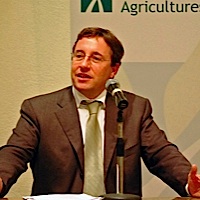
Agriculture and food are urgent global priorities with farmers on the front line of some of the world’s most pressing issues. Putting farmers at the vanguard of responses to the food crisis and climate change in Africa and beyond is vital.
Putting farmers at the centre of agricultural innovation and development is the subject of a new Practical Action Publishing book, Farmer First Revisited: Innovation for Agricultural Research and Development, edited by Ian Scoones and John Thompson, foreword by Robert Chambers and launched today in Nairobi, Kenya, by Achim Steiner, Executive Director of the United Nations Environment Programme (UNEP) and Carlos Sere, Director General, International Livestock Research Institute (ILRI).
The book’s 150 contributors review cases of farmer-led innovation in 30 countries around the world over the past twenty years. It aims to re-energise the debate about farmer involvement in agricultural research and development, refine the „farmer first approach? methodologies and set new challenges and goals for the immediate and long-term future.
Farmer First Revisited discusses:
- The methods, institutions and support systems required to transform agriculture research and development systems
- How farmer first approaches can help boost production and get the right seeds and other inputs into the hands of farmers
- How farmers can lead climate adaptation responses, using local knowledge and systems to improve resilience and the capacity to change
The book is published twenty years after the original „Farmer First? book, when the idea of promoting farmer-led agricultural innovation was considered a marginal, almost subversive, issue. This was followed in 1994 with „Beyond Farmer First?. But today mainstream opportunities exist for transforming agriculture and putting farmers firmly in the driving seat of change.
In the intervening two decades, the Farmer First movement – a loose, informal network stretching across the world – has experimented with a range of participatory approaches to agricultural research and extension with farmers at the heart of the innovation process.
Participatory plant breeding, for example, has involved farmers in the process of choosing and testing new crop varieties. Extension systems have equally been transformed, moving from top-down instruction towards farmer-to-farmer exchange and joint learning. The use of new information technologies has expanded too, allowing information sharing between farmers. As a result, farmers are increasingly seen as partners in the innovation process, rather than merely recipients of national and international research and extension systems.
Yet failures of conventional agriculture and associated institutional arrangements are apparent everywhere. The generation of an African Green Revolution, for example, requires a new agriculture based on partnerships, not top-down impositions and rooted in diverse knowledges rather than singular technical solution. Wider perspectives on innovation, linking with research and markets, technology development and users are needed.
Judi Wakhungu, Executive Director, African Centre for Technology Studies, Nairobi, Kenya and co-chair International Assessment of Agricultural Science, Knowledge and Technology for Development (IAASTD) argues the book shows “why we need to continue questioning conventional assumptions about agriculture, and why multiple knowledges and sources of innovation are more important than ever.”
That opportunities exist for farmers to drive this innovation are especially evident in Africa. Government commitments through the CAADP/NEPAD framework are in place; funding support is being channelled through organisations like AGRA; and policy wider commitments are being affirmed by the IAASTD, the World Bank’s World Development Report on agriculture and the discussions around the Global Partnership for Agriculture.
And as this new book shows, there are two decades of „farmer first? experiences to build on.
Gordon Conway, Chief Scientific Adviser at the UK Department for International Development (DFID) notes: “Twenty years on and the concepts and practices of Farmer First remain powerful and compelling, and even more relevant in today’s world”.
Joachim Voss, former Director General of the International Centre for Tropical Agriculture in Colombia comments: “Farmer First has won broad acceptance by rigorously proving its superior efficiency in making science work for the poorest and most marginal farmers. It is indeed a pleasure to see how the established and dedicated practitioners, together with a new generation of committed young scientists, have built upon the original concepts and methods to create this dynamic, exciting and effective corpus of work.”
{jcomments on}
Rising food prices: A global crisis
April 1, 2008 / Miscellaneous{jathumbnail off}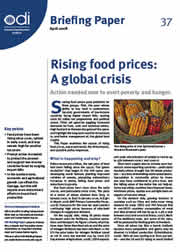 Soaring food prices pose problems for three groups. First, the poor whose ability to buy food is undermined. Second, governments of low-income countries facing higher import bills, soaring costs for safety net programmes and political unrest.
Soaring food prices pose problems for three groups. First, the poor whose ability to buy food is undermined. Second, governments of low-income countries facing higher import bills, soaring costs for safety net programmes and political unrest.
Third, aid agencies juggling increased demands for food, cash and technical advice. High food prices threaten the gains of the 1960s and highlight the long-term need for investment in, and better management of, the global food supply. This Paper examines the causes of rising food prices, expected trends, the likely impact, and possible policy responses.
Evaluation of the 2006/7 Agricultural Input Subsidy Programme, Malawi: Final Report
March 12, 2008 / MiscellaneousThis report evaluates the 2006/7 Malawi Government Agricultural Input Subsidy Programme (AISP). The main objective of the evaluation is to assess the impact and implementation of the AISP in order to provide lessons for future interventions in growth and social protection. The evaluation combined qualitative and quantitative methods of data collection and analysis.
Quantitative data were collected through a national survey in 2007 of 2,491 households who were previously interviewed in the 2004/05 Integrated Household Survey, a survey of retail shops selling inputs in six districts and data on stocks and sales from manufacturers, large-scale importers and dealers of fertilizers and seeds.
The quantitative data was triangulated by qualitative data from focus group discussions with smallholder farmers in 12 districts, and key informant interviews with government staff, input distributors and beneficiary and non-beneficiary households. The analysis is based on descriptive statistics, econometric modelling and livelihood and rural economy modelling. An Interim Report in March 2007 provides fuller details of the implementation of the programme.
Cadres politiques propices à l’amélioration de la fertilité des sols en Afrique
March 5, 2008 / Briefings politiques / Policy briefs in FrenchChacun convient du fait que l’une des composantes centrales, pour parvenir à une « révolution verte africaine », porte sur la nécessaire résolution des problèmes majeurs de fertilité des sols qui pèsent sur l’agriculture africaine. A cet effet, l’AGRA (Alliance pour une révolution verte en Afrique) a lancé un nouveau programme de grande envergure, baptisé « Soil Health » (fertilité des sols) et concernant 4,1 millions d’agriculteurs en Afrique, ceci avec le soutien de la Fondation Bill and Melinda Gates, dont la contribution s’élève à 198 millions de dollars (www.agra-alliance.org/section/work/soils). La déclaration d’Abuja, en conclusion du sommet de l’Afrique sur les engrais qui s’est tenu en 2006, a instauré un contexte propice à des investissements majeurs visant à stimuler l’approvisionnement en engrais (www.africafertilizersummit.org/Abuja Fertilizer Declaration in French.pdf). Le CAADP (Programme global de développement de l’agriculture africaine) a joué un rôle actif dans le cadre des activités de suivi du sommet, notamment par son travail sur l’amélioration des marchés et des échanges (www.triomedia.co.za/work/nepad/newsletters/2008/issue212_15Feb2008.html#toc1 ). On recense par ailleurs de nombreuses autres initiatives, notamment le programme Villages du millénaire (www.millenniumvillages.org/ ), le programme Sasakawa-Global 2000 (www.saa-tokyo.org/french/sg2000/), ainsi que les activités de l’Association for Better Land Husbandry (Association pour une meilleure utilisation des terres d’élevage). Toutes ces initiatives considèrent la fertilité des sols comme une question centrale, même si les solutions et conditions politiques suggérées sont très différentes les unes des autres.
Commercialisation of Smallholder Agriculture in Selected Tef-growing Areas of Ethiopia
March 2, 2008 / Discussion PapersBy Samuel Gebreselassie and Kay Sharp
The poverty-reduction strategy adopted by Ethiopia seeks to achieve growth through the commercialisation of smallholder agriculture. The Plan for Accelerated and Sustainable Development to End Poverty (PASDEP), Ethiopia?s strategic framework for 2005/06 – 2009/10, relies on a massive push to accelerate growth. This is to be achieved by efforts in two directions: commercialisation of agriculture, based on supporting the intensification of marketable farm products (both for domestic and export markets, and by both small and large farmers); and promoting much more rapid non-farm private sector growth (MoFED, 2005). This study aims to contribute to this plan by identifying factors that can deepen and expand the scope of market participation of smallholders.
Narratives of Agricultural Policy in Africa: What Role for Ministries of Agriculture
March 1, 2008 / Research PapersBy Lidia Cabral and Ian Scoones
March 2006
Much policy research on African agriculture has focused more on ‘what policy’ type of questions, rather than on the processes by which policy is made and implemented (Omamo, 2004). The focus has been on ‘policy fixes’, based often on idealised models of the way things should be, rather than the way they are, or are likely to be.
The Social Protection Policy in Malawi: Processes, Politics and Challenges
February 7, 2008 / Policy BriefsPolicy Brief 24
By Blessings Chinsinga
February 2008
The livelihoods of Malawians are much more precarious today than they were probably two decades ago. Repeated shocks over the years have forced most households to dispose of key productive assets to meet immediate consumption needs, leaving them incapable of maintaining sustainable livelihoods.
Malawi’s Agriculture Ministry: Fit for Purpose?
February 6, 2008 / Policy BriefsPolicy Brief 23
By Blessings Chinsinga and Lídia Cabral
February 2008
Malawi’s Ministry of Agriculture (MoA) has a mandate to promote and accelerate broad-based and sustainable agricultural development, so as to stimulate economic growth and contribute to poverty reduction. The MoA is responsible for policy formulation and regulation, the coordination of training and collaboration with other stakeholders in the agriculture sector, and supervision of parastatal organisations, for which it also guarantees loans.
The Malawi Fertiliser Subsidy Programme: politics and pragmatism
February 5, 2008 / Policy BriefsPolicy Brief 22
By Blessings Chinsinga
January 2006
Many people hoped that the end of one-party rule in Malawi in May 1994 would pave the way for economic recovery and social development. Instead, however, the democratisation process has coincided with a deepening crisis in Malawi’s agricultural sector. Between the 1970s and the 1990s, the country went from producing an agricultural surplus to a substantial food deficit. Per capita maize production fell significantly during the 1990s.
Smallholder Coffee Commercialisation in Malawi
February 4, 2008 / Policy BriefsPolicy Brief 21
By Ephraim Chirwa, Andrew Dorward and Jonathan Kydd
February 2008
Coffee cultivation in Malawi is dominated by a small number of large-scale commercial estates, located mainly in the Southern region. In the Northern and Central regions, however, coffee is grown predominantly by large numbers of smallholder farmers on customary land, concentrated in the districts of Chitipa, Rumphi, Mzimba and Nkhata-Bay.
Using Social Protection to Reduce Vulnerability and Promote Economic Growth in Kenya
February 3, 2008 / Policy BriefsPolicy Brief 20
By John Omiti
February 2008
While reducing risk and vulnerability, social protection (SP) measures can also promote productive activity and economic growth. This paper discusses how SP policies can be used to address key aspects of risk and vulnerability, and to promote economic growth in agriculture.
The Politics of Policy Reforms in Kenya’s Dairy Sector
February 2, 2008 / Policy BriefsPolicy Brief 19
By Rosemary Atieno and Karuti Kanyinga
Febuary 2008
Recent reforms of Kenya’s dairy sector have been hailed as a long-term success story. This paper discusses the strengths and limits of Kenya’s dairy sector reforms and identifies some lessons to be drawn from its experience.
La politique de protection sociale au Malawi : processus, politiques et défis
February 1, 2008 / Briefings politiques / Policy briefs in FrenchLes moyens d’existence des Malawites sont probablement beaucoup plus précaires aujourd’hui qu’il y a deux décennies.Les crises répétées sur plusieurs années ont contraint la plupart des foyers à abandonner leurs principaux actifs de production afin de répondre à leurs besoins immédiats, les empêchant de conserver des moyens de subsistance durables.
Le ministère de l’Agriculture au Malawi remplit-il bien sa mission ?
February 1, 2008 / Briefings politiques / Policy briefs in FrenchLa mission du Ministère de l’Agriculture (MdA) est de promouvoir et d’accélérer un développement agricole diversifié et durable, pour stimuler la croissance économique et contribuer à la réduction de la pauvreté. Le MdA est chargé de promulguer des lois, de réguler les affaires agricoles, coordonner la formation, et collaborer avec les autres dépositaires d’enjeux du secteur ; il supervise aussi les organismes paragouvernementaux auxquels il accorde des prêts.
The Revitalisation of Kenya Cooperative Creameries
February 1, 2008 / Research PapersRosemary Atieno and Karuti Kanyinga
February 2008
This paper presents a case study of politics of policy reforms in the dairy sector in Kenya with particular reference to the Kenya Cooperative Creameries (KCC). It is developed for the Policy Processes sub theme of the Future Agricultures Consortium (FAC).
The sub theme recognises that that while many policy recommendations on how to get agriculture moving have been made, too often such recommendations have foundered. This has been attributed to among other things, the narrow focus on the technical dimensions of policy, with little attention paid to the political economy and the complex politics of policy making in specific contexts (FAC 2007).
Rethinking Agricultural Input Subsidies in Poor Rural Economies
February 1, 2008 / Policy BriefsPolicy Brief 18
By Andrew Dorward, Peter Hazell and Colin Poulton
February 2008
Agricultural input subsidies were a common element in agricultural development in poor rural economies in the 1960s and 70s, including successful green revolutions. Although subsidies have continued, to a greater and lesser extent, in some countries, conventional wisdom as well as dominant donor thinking in the 80s and 90s was that subsidies had been ineffective and inefficient policy instruments in Africa, which contributed to government over-spending and fiscal and macro-economic problems.
Mid Term Review Future Agricultures Consortium
November 1, 2007 / MiscellaneousThe Future Agricultures Consortium (FAC) is a project funded by the Renewable NaturalResources and Agriculture 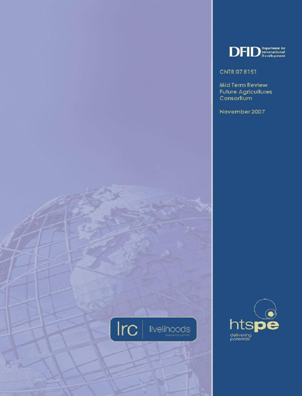 (RNRA) Team of DFID’s Policy Division. It is a project that has the aim to improve the quality of public policy towards agriculture in low income Sub- Saharan Africa (SSA) countries. This objective arises from DFID’s Policy Paper onagriculture published in 2005 (DFID, 2005), in which the central importance of agricultural growth for poverty reduction in countries where the majority of the poor live in rural areas is affirmed. The project began in May 2005 and is scheduled to complete its current phase in March 2008. The project team has submitted a proposal to DFID for a second phase of the project to last from April 2008 to March 2011. The tasks of this mid-term review are asfollows (see Review TOR at Annex A):
(RNRA) Team of DFID’s Policy Division. It is a project that has the aim to improve the quality of public policy towards agriculture in low income Sub- Saharan Africa (SSA) countries. This objective arises from DFID’s Policy Paper onagriculture published in 2005 (DFID, 2005), in which the central importance of agricultural growth for poverty reduction in countries where the majority of the poor live in rural areas is affirmed. The project began in May 2005 and is scheduled to complete its current phase in March 2008. The project team has submitted a proposal to DFID for a second phase of the project to last from April 2008 to March 2011. The tasks of this mid-term review are asfollows (see Review TOR at Annex A):
(a) to assess the likelihood of FAC meeting its purpose to ‘encourage dialogue and sharing ofgood practice by policy makers and opinion formers in developing countries on the roleof agriculture in broad based growth’;
(b) to make recommendations on the FAC plan for the remaining 6 months of their currentfunding period (to March 2008); and
(c) to make recommendations on the FAC proposal for extension and expansion beyondMarch 2008.
Agriculture has certainly been moving up the strategic poverty reduction agenda in SSA.Agriculture often has a key position in individual country’s PRSPs (for example, the EthiopiaPASDEP is largely built around a strategy entitled Agricultural Development LedIndustrialization), and the sector has become a priority strategic focal point for NEPAD in theshape of its Comprehensive Africa Agriculture Development Programme (CAADP).
Many international reports on the achievement of the Millennium Development Goals have alsoaccorded agriculture special strategic priority; for example, the UN Millennium Project(2005), the Africa Commission (2005), and of course most recently the World DevelopmentReport 2008 (World Bank, 2007), the preparation of which involved significant contributionsfrom members of FAC.FAC operates at the intersection of knowledge and policy.
This is a difficult intersection atwhich to work. On the one hand, the knowledge side of this interaction may be incomplete,contested, and complex to the extent that straightforward messages are difficult to formulateand convey. On the other hand, policy often represents a considerable dead weight of pastpractice, entrenched organizations and interests, and unwillingness to reorder priorities.Moreover, the personal and political interests that make some policy options more attractivethan others to public decision makers can be exceedingly difficult to decipher or anticipate.
What FAC sets out to do is to try to open up this policy space so that information and optionscan circulate more freely, and good ideas may stand a better chance of being taken up. Thereis no doubt that this is a worthwhile activity. FAC’s relative success to date in achieving thisobjective, and the way it might go about doing this more effectively in the future, are thefocal points of this review.
Les commercialisations agricoles: les conditions égales pour les petits exploitants agricoles ?
October 1, 2007 / Briefings politiques / Policy briefs in FrenchLa croissance accélérée de l’agriculture est considérée par beaucoup comme déterminante pour répondre aux OMD en Afrique. Pour de nombreux gouvernements nationaux et associations internationales de développement, l’intensification et la commercialisation de l’agriculture paysanne jouent un rôle déterminant dans la réduction de la pauvreté. Les avantages potentiels de la commercialisation sont très bien documentés. Selon ce courant de pensée, l’agriculture paysanne a une position unique pour assurer une croissance à large assise dans les zones rurales où la plus grande majorité de la population pauvre mondiale vit toujours.
Agricultural Commercialisations – A Level Playing Field for Smallholders?
October 1, 2007 / Policy BriefsPolicy Brief 17
By Jennifer Leavy and Colin Poulton
Accelerated growth in agriculture is seen by many as critical to meeting MDGs in Africa. Many national governments and international development agencies see intensification and commercialisation of smallholder agriculture playing a central role in achieving poverty reduction. The potential benefits of commercialisation are well documented. According to this thinking, smallholder agriculture is uniquely positioned to deliver broad-based growth in rural areas, where the vast majority of the world’s poor people still live.
FAC Meetings Series, Autumn 2007
October 1, 2007 / Miscellaneous{jathumbnail off}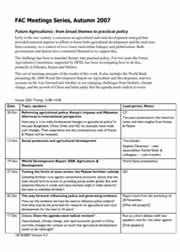 Early in the new century a consensus on agricultural and rural development emerged that provided renewed impetus to efforts to boost both agricultural development and the rural non-farm economy, in a context of ever closer rural-urban linkages and globalisation.
Early in the new century a consensus on agricultural and rural development emerged that provided renewed impetus to efforts to boost both agricultural development and the rural non-farm economy, in a context of ever closer rural-urban linkages and globalisation.
Both governments and donors have committed themselves to support this.The challenge has been to translate themes into practical policy. For two years the Future Agricultures Consortium, supported by DFID, has been investigating how to do this,primarily in Ethiopia, Kenya and Malawi.
This set of meetings presents of the results of this work. It also includes the World Bank presenting the 2008 World Development Report on Agriculture and Development, and two sessions on the way forward and whether or not emerging challenges from biofuels, climate change, and the growth of China and India imply that the agenda needs radical revision.
Synthesis Report for Theme III. Growth and Social Protection
October 1, 2007 / MiscellaneousBy Rachel Sabates-Wheeler, Andrew Dorward, John Omiti, Stephen Devereux, Amdissa Teshome, Ephraim Chirwa
October 2007
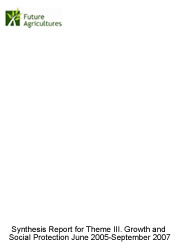 This report describes the main activities and outputs of the Future Agriculture Consortium(FAC) under the theme of Growth and Social Protection for Phase I. Core work on the theme has involved the development of a conceptual framework setting out potential and evolving synergies and conflicts between social protection and agricultural growth in the livelihoods of poor and vulnerable people, in local and national economies, and in policy formulation and implementation.
This report describes the main activities and outputs of the Future Agriculture Consortium(FAC) under the theme of Growth and Social Protection for Phase I. Core work on the theme has involved the development of a conceptual framework setting out potential and evolving synergies and conflicts between social protection and agricultural growth in the livelihoods of poor and vulnerable people, in local and national economies, and in policy formulation and implementation.
Publication and discussion of the framework has led to its uptake outside the FAC and in the country theme work. In Ethiopia and Malawi this has engaged strongly with evaluations and national and donor policy reviews of innovative and major national social protection and/or agricultural growth policies.
Such engagement has, necessarily, followed the national rather than FAC timetable, and hence theme work in these two countries has not reached the planned September completion; this is a price worth paying for the opportunities to learn from and contribute to these major national programmes, which have continent-wide relevance. In Kenya, theme work has explored, with national stakeholders, the multiple and often uncoordinated social protection interventions of different players, as well as their actual and potential interactions with agricultural development.
This work has generated considerable interest and provides a platform for rethinking and improving policies and interventions. Work on this theme has achieved considerable leverage through its integration with non-FAC work being conducted by FAC-members and by stimulating interest in the theme by other players. There are also strong cross-theme linkages through work on the policy processes of social protection and agricultural policy development, and through recognition of the importance of labour markets and on- and off-farm diversification in social protection /agriculture livelihood linkages.
Further work in the remainder of Phase I will involve writing up and reporting the work in Ethiopia and Malawi, and synthesis of this with other work being conducted by consortium members, with particular emphasis on cross-country lesson-learning.
{jcomments off}
Agricultural Commercialisations
September 24, 2007 / Miscellaneous{jathumbnail off}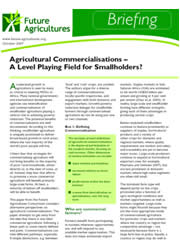 Accelerated growth in agriculture is seen by many as critical to meeting MDGs in Africa. Many national governments and international development agencies see intensification and commercialisation of smallholder agriculture playing a central role in achieving poverty reduction. The potential bene.ts of commercialisation are well documented.
Accelerated growth in agriculture is seen by many as critical to meeting MDGs in Africa. Many national governments and international development agencies see intensification and commercialisation of smallholder agriculture playing a central role in achieving poverty reduction. The potential bene.ts of commercialisation are well documented.
According to this thinking, smallholder agriculture is uniquely positioned to deliver broad-based growth in rural areas, where the vast majority of the world’s poor people still live. Others fear that strategies for commercialising agriculture will not bring bene.ts to the majority of poor rural households, either directly or, in the view of some, at all. Instead, they fear that efforts to promote a more commercial agriculture will benefit primarily large-scale farms. At best, a minority of better-off smallholders will be able to bene. This paper from the Future Agricultures Consortium considers alternative perspectives on agricultural commercialisation. The paper attempts to get away from the idea that there is one ideal commercial agriculture, following a linear path to some clearly de.ned end point.
Commercialisations can take different pathways, especially if simple distinctions, e.g. between ‘food’ and ‘cash’ crops, are avoided. The authors argue for a diverse range of commercialisations, locally speci.c trajectories, and engagement with both domestic and export markets. Growth-poverty reduction linkages for smallholder farmers through commercialized agriculture do not lie along just one or two channels.
